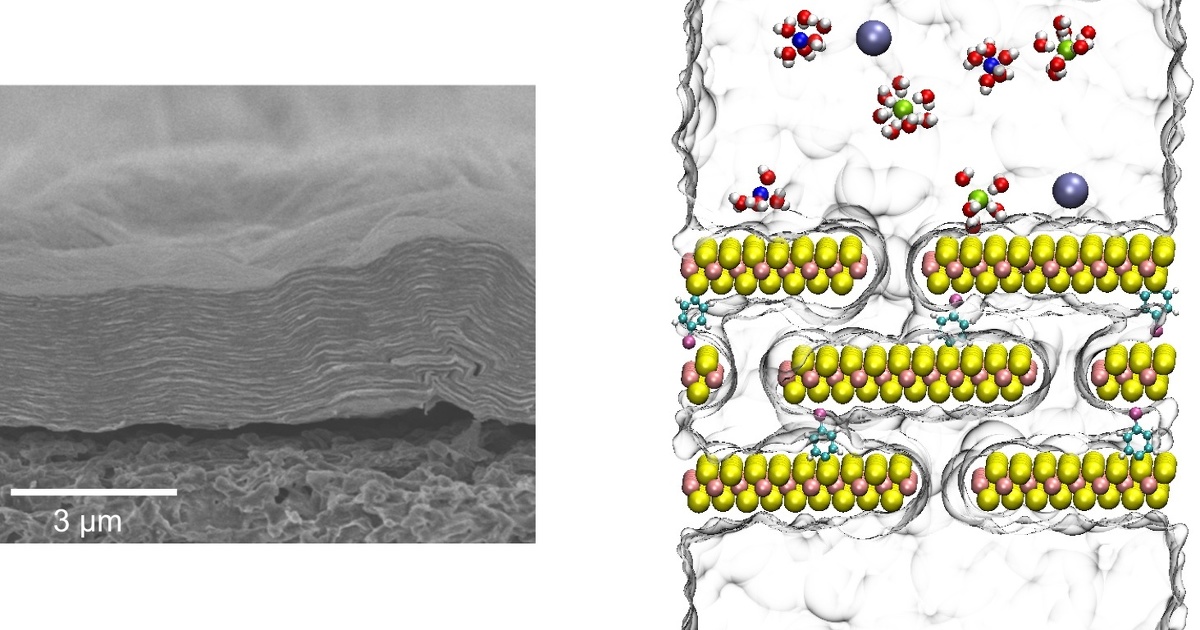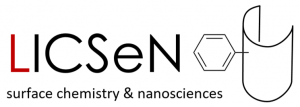Summary: Nanomaterials hold promise for the development of innovative membranes towards the purification of water and desalination. Two-dimensional materials (2D) when stacked in 2D nanolaminates have been investigated for molecular sieving via size-limited diffusion in the 2D capillaries while nanofluidic ionic diodes can efficiently control the diffusion of ions depending on their charges. Within 2D-MEMBA, we propose to realize and study novel designs of membranes combining nanolaminates and ionic diodes. To reach this goal we will first elucidate the role of surface chemistry on the structural and nanofluidic behaviours of nanolaminates made of charged and/or functionalized nanosheets. We will then investigate the ion and water permeation through the nanolaminate/ionic diodes hybrids under forward and reverse osmosis configurations. Our concerted effort will not only provide insight on nanofluidics but will also lead to practical strategies for large-scale applications for water treatment.
Consortium
- Damien Voiry (Institut Européen des Membranes); Coordinator;
- Drummond Carlos (formerly Dr. Alain Penicaud, now retired) (C.R.P.P. Centre de Recherche Paul Pascal); task leader;
- Jean-Christophe P. Gabriel (NIMBE Nanosciences et innovation pour les matériaux, la biomédecine et l’énergie); task leader.
Other Project’s members:
- Emilie Rolland (11/2024 – 10/2027) – Ph.D. student at NIMBE, Université Paris Saclay
- Dr. Sarah Chevrier (2022/2024) – Ph.D. student at NIMBE, Université Paris Saclay
- Liloo Romain (01-10/2024) – Engineer at CRPP
- Mathilde Moderne – PhD student at IEM, Montpellier University
Latest news:
- 19/08/2024: 2D-MEMBA CRPP team members just published its latest article entitled: “Graphene in Water is Hardly Ever Neutral” in the high impact journal Advanced Science (IF 2023 =14.3). The abstract explains: “Graphene in water is electrically charged in most conditions. The level of charge can be large enough to stabilize single (or few) layer graphene colloidal dispersions in water, without the need of using any other additive. In this work, potentiometric titration, isothermal titration calorimetry, electrokinetic measurements, Density Functional Theory calculations, Raman Spectroscopy, and direct force measurements using Atomic Force Microscopy to investigate this charge and explore its origin are combined. The body of data collected suggests that this charge is a consequence of the interaction between water ions (hydroxide and hydronium) and graphene, and can be conveniently tuned (in magnitude and sign) by changing the pH of water.”
- 23/05/2024: Our latest article by former 2D-MEMBA PhD student, Dr. Sarah Chevrier, entitled « Gas Permeation through V2O5 Nanoribbons-Based Membrane » was just published on line in the new journal Advanced Materials Interfaces and is available for all to read (in open access). It is our fist article on the integration of the charged 2D lyotropic mineral materials, a type of materials that we have been working on for decades, for the making of membranes, here for gas separation. These first and very promising results are highly encouraging and confirm the potential interest of these materials in this field. N.B. we discovered the gas separation potential of these membrane in the context of testing them for pinholes, prior to test them for their water filtration potential. © CEA

- 14/05/2024: Today, 2D-MEMBA’s coordinator Damien Voiry, together with his co-workers, published a review entitled “Functionalized 2D nanolaminate membranes for nanofluidics and molecular sieving.” in the high impact journal Trends in Chemstry (IF 2023 =14). Its abstract explains that “this review summarizes the nanochemistry strategies for engineering 2D materials and discusses the effect of nanosheet modification on the nanochannel architecture (interlayer space) and surface physiochemical properties (charge, affinity, and hydrophilicity) of the nanolaminate membrane. It also sheds light on the importance of the physical and chemical properties of the nanosheets in tailoring the performance of 2D material nanolaminate membranes (2DMMs) for selective sieving. We finally discuss the remaining challenges and opportunities associated with the development of 2DMMs.”
- 03/04/2024: Today, 2D-MEMBA funded PhD student, Ms Sarah Chevrier, received many praises and congratulations from the Jury following her Ph.D. defence. She has therefore been granted the diploma of Doctor of the University Paris Saclay, France’s best scientific University and will now pursue her career at the Air Liquide’s research centre. A pdf version of her official PhD Manuscript is available here .
- 18/02/2024: A second article is published by the 2D-MEMBA CRPP’s team entitled “Influence of Defects and Charges on the Colloidal Stabilization of Graphene in Water” was published today in the International peer reviewed journal Chemistry A European Journal. In this work, they prove that electrostatic forces are responsible for the stability of fully exfoliated graphene in water, and explore the influence of the oxidation and solvent exchange procedures on the quality and stability of aqueous graphene dispersions (Eau de graphene, EdG). They show that the amount of defects in graphene is limited if graphenide oxidation is carried out before exposing the material to water, and that gas removal of water before the incorporation of pre-oxidized graphene is advantageous for the long-term stability of EdG. Full article is available here. © CRPP.

- 08/03/2023: publication of 2D-MEMBA’s first article entitled “New direct osmosis membranes based on two-dimensional nanomaterials”: With climate change and population growth, securing water resources has become one of the greatest challenges of the coming decades. To meet growing demand, water must now be recovered and purified. An international team led by Damien Voiry at the European Membrane Institute (CNRS/ENSC Montpellier/University of Montpellier) recently developed new direct osmosis membranes based on two-dimensional nanomaterials. These results have been published in the journal Nature Water. By optimising the manufacture of nanolaminate membranes, they have developed relatively large surface area membranes with sizes greater than 45 cm2, which demonstrate a salt rejection of more than 94% for a continuous operating time of 7 days.Look here for the full news.
- Media coverage: 06/04/2023 in Actu Environment: “Vers des membranes de filtration plus sobres en énergie”
 Between the leaves, a controlled space allows water molecules to pass through, but retains larger contaminants. © IEM
Between the leaves, a controlled space allows water molecules to pass through, but retains larger contaminants. © IEM
- Media coverage: 06/04/2023 in Actu Environment: “Vers des membranes de filtration plus sobres en énergie”





